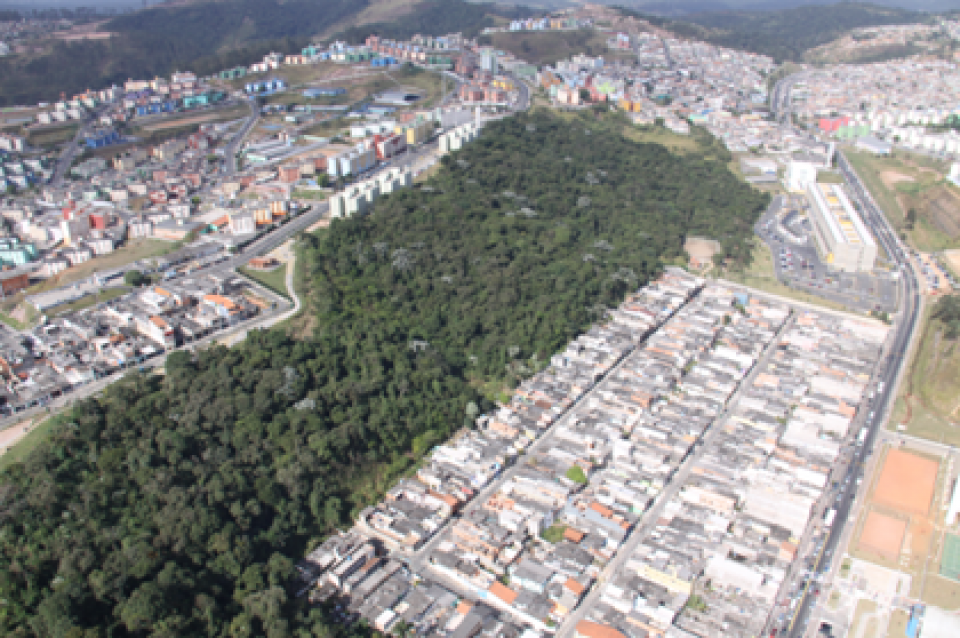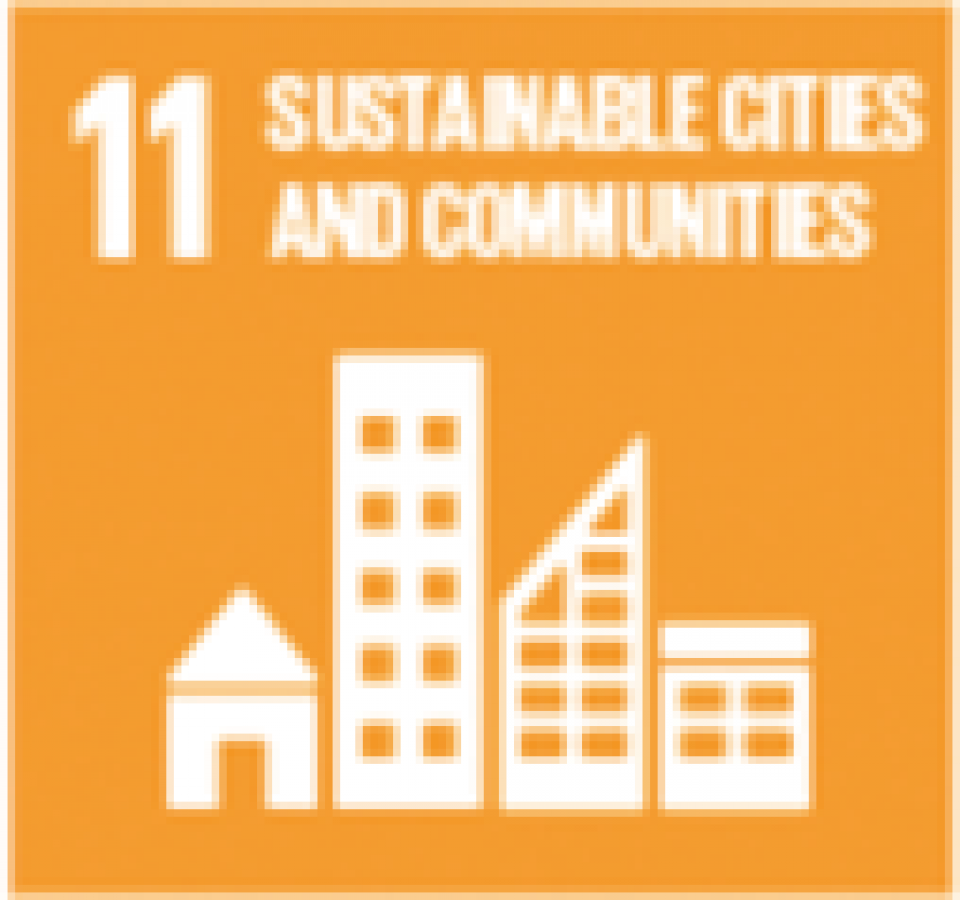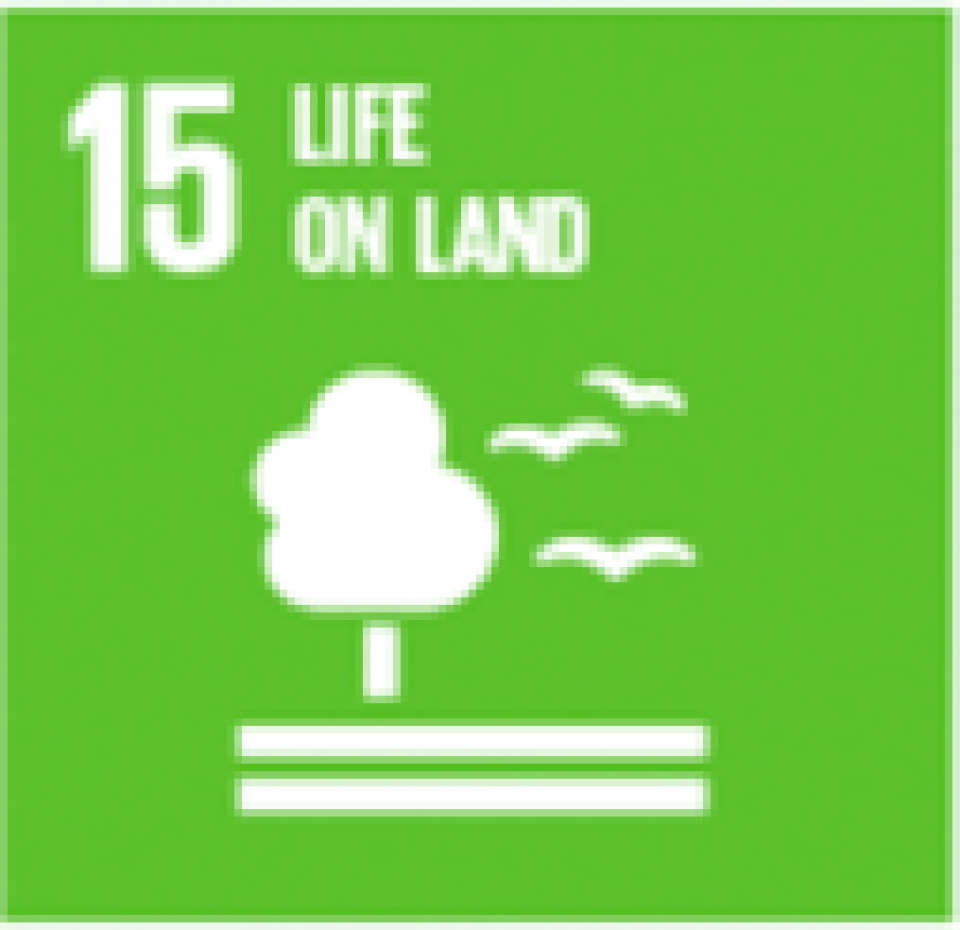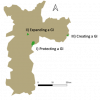
With a population of almost 12 million and covering an area of 1512 km2, São Paulo is the largest city of Brazil and capital of the homonymous State. It has an urbanisation rate of above 99%, following an urbanisation model based on the occupation of environmentally fragile areas and encroachment of natural habitats. As a result, the city faces important socio-environmental challenges linked to urban drainage (e.g. landslides, flooding), contamination of air and water sources, sanitation systems, and climate change. These challenges disproportionately affect the poorest segments of the population and contribute to the deterioration of local ecosystems and ecosystem services such as carbon sequestration, hydraulic and temperature regulation, and biodiversity protection.
Vegetation cover is present in about 48% of São Paulo City, with the rural area occupying 31.78% of the municipal territory and sheltering 79.37% of this cover, and the urban area occupying 68.22% of the territory and sheltering 33.65% of the total vegetation cover (São Paulo, 2020). While the vegetation cover per inhabitant is on average 62,88 m², the distribution of green is highly unequal, with the lowest figure of 5,22 m²/inhabitant in the Sapopemba Regional Administration, and the largest figure of 2,000 m²/inhabitant in the Parelheiros Regional Administration, mostly inserted in the rural area (São Paulo, 2020).
The City manages nine Conservation Units which span 30% of the municipal territory and protect important remnants of the Atlantic Forest biome, including indigenous lands such as Tenondé Porã, in the Parelheiros Regional Administration, and Jaraguá, in the Pirituba-Jaraguá Regional Administration. In addition, São Paulo City and State government manage 131 public parks which provide valuable environmental services to millions of people (São Paulo, 2022).
In the context of the H2020 CONEXUS project, the São Paulo Life-Lab establishes pilots in three parks, respectively to protect, expand, and create urban green infrastructure (GI) through nature-based solutions (NbS) interventions. The first pilot (I) is located in the Parque Estadual das Fontes do Ipiranga – PEFI, a large Atlantic Rainforest remnant with more than 520 ha of well-preserved forest in the southeast of the city. The second (II) unfolds in the Ibirapuera Park, a historic public park of more than 150 ha close to the city centre and encompassing a heterogeneous landscape with scattered forest patches and large green open spaces. The third (II) is situated in the Consciência Negra/Mata Sete Cruzes, a recently established park in the extreme eastern border of the City, which includes 20 ha of degraded land to be restored.
The main objective of the São Paulo Life-Lab is to fast-forward the urban green transition by harnessing the ecosystem services of urban forests, and while doing so, tackling socio-environmental inequalities through NbS co-creation.
The Life-Lab thus aligns with the wider vision of São Paulo City to promote urban forests as global solutions to climate change and other sustainable development challenges, including with strategic policy agendas like the 'Municipal Plan for Protected Areas, Green Areas and Open Spaces', the 'Municipal Plan for the Conservation and Recovery of the Atlantic Forest', the 'Programme for Payments of Environmental Services', the 'Municipal Plan for Urban Afforestation' and the 'Municipal Climate Action Plan', put forward as instruments for carrying out the '2030 Municipal Agenda of the City of São Paulo', launched in June 2021 (WRI, n.d.).
In their different contexts, the three CONEXUS pilots leverage biodiversity to optimise the ecosystem services of urban forests at the micro and meso-scales.
Pilot 1, in the Parque Estadual das Fontes do Ipiranga – PEFI, consists of the protection of a large Atlantic Rainforest patch. Carbon sequestration and thermal comfort are being monitored at different scales to understand the contribution of a remnant of the Atlantic Rainforest to the quality of life in the city. An Eddy Covariance tower, a high-tech instrument set at 18m above the ground, is measuring the exchanges of CO2, water, and energy between the park and the atmosphere. Additionally, the same fluxes are being measured in four native tree species to understand their contributions in terms of ecosystem services.
Pilot 2 supports the expansion of Ibirapuera Park. The same monitoring system has been set in this public park boosting a distinct vegetation cover. The fluxes of CO2, water, and energy are being measured for the entire park, as well as the contribution of four native tree species in the delivery of these ecosystem services. The role of the park's trees on filtering air pollution is also monitored.
Pilot 3 involves the collaborative restoration of a portion of the planned Mata Sete Cruzes/Cabeceiras do Aricanduva Park, the afforestation of Consciência Negra Park, and the establishment of a green corridor connecting them to Ciência Park. A new green infrastructure will be created by the local communities together with a multidisciplinary technical team of urban planners, architects, biologists, agronomist, and other practitioners. The project is a collaboration between the Municipal Secretariat of Green and Environment (SVMA), Cidade Tiradentes’ Regional Administration, and São Paulo Housing Company (COHAB). Currently, the SVMA is creating a working group to explore methodologies and guidelines to guide the development of the green corridor.
Linked to the monitoring study, a programme of environmental education will be launched by the Life-Lab to capacitate local communities in the development and maintenance of urban forests as strategic elements of urban liveability and sustainability. In fact, urban forests are seen as solutions that go beyond addressing local environmental issues, but tackle global challenges such as pollution and climate change.
See also: urban forests and promotion of native ecosystems case study.
- Protection, restoration, and enhancement of biodiversity, including through the creation of biodiversity corridors connecting green urban areas;
- Harnessing of forest ecosystem services including benefits for climate change resilience (i.e. carbon sequestration, temperature regulation, reduction of air pollution);
- Creation of a system for managing green public areas by the Cidade Tiradentes’ Regional Administration;
- Place regeneration through improved quality and public value of green infrastructure (e.g. for recreation);
- Strengthening ‘sense of place’ and local identity by improving the perception of local environments and landscapes;
- More open, transparent, participatory, and inclusive processes for green infrastructure planning and governance;
- Amplifying community engagement in and management of co-created NbS;
- Expanded knowledge-base for upscaling the integration of ecosystem services into sustainable urbanisation actions;
- Trialling and development of a methodology to implement green corridors in other areas of São Paulo City.
A pool of learnings towards effective implantation of NbS are being gathered by the Life-Lab:
- It has been challenging to integrate the rich biodiversity of the Atlantic Rainforest Biome into NbS initiatives; similarly, expanding interventions to wider geographical scales requires vertical and horizontal governance coordination.
- Engaging local stakeholders in support of pilot implementation takes time but yields results in the longer term.
- Highly dense and informal areas often lack space for green infrastructure. It is ever more urgent to use NbS to remedy socio-environmental injustices.
- It is necessary to include minority groups in the participatory design and management phases of NbS interventions to make sure their needs and aspirations are reflected and they do not end up being worse off from the intervention.
- NbS, compared to more traditional approaches of urban planning, are difficult to upscale because of their transversal nature.
- The public sector does not have knowledge and experience to implement NbS. Multidisciplinary partnerships and capacity-building are needed. In this sense, it is important to co-create NbS via cross-sectoral, multi-level articulations between public and private sectors, communities, academia, and other stakeholders.
- There is knowledge gap in relation to the long-term maintenance and cost-efficiency of NbS.
- Budget availability remains a challenge to finance and implement NbS.
- Horizon 2020 programme
- São Paulo Research Foundation (FAPESP 2019/08783-0)
- Municipal funding, São Paulo City Government
- urban forest restoration
- urban green system
Sao Paulo Life-Lab:
- Alexandra Aguiar Pedro, Prefeitura Municipal de São Paulo, aapedro@prefeitura.sp.gov.br
- Wellington Tohoru Nagano, Prefeitura Municipal de São Paulo, wtnagano@prefeitura.sp.gov.br
- Giuliano Locosselli, USP, locosselli@cena.usp.br
- Paulo Pellegrino, USP, prmpelle@gmail.com
SDGs/NUA data:
- Federica Risi, EUKN, federica.risi@eukn.eu
Further information
References
- CONEXUS Deliverable 3.1 Report with action plans for each Life-Lab (internal).
- CONEXUS Deliverable 2.2 Seven detailed EU and CELAC cases on NbS challenges and opportunities addressed: ‘Integration of NbS in local governance contexts and urbanisation trajectories in CONEXUS EU and CELAC cities. Evidence from Barcelona, Buenos, Aires, Bogotá, Lisbon, Santiago, São Paulo and Turin.’
- CONEXUS Deliverable 4.1 Assessment framework, indicators and participatory monitoring process.
- CONEXUS Deliverable 6.1 Report. Data on SDG/NUA impacts/potentials linked with investment propositions uploaded to Oppla.
- Locosselli, G. M. and Buckeridge, M. S. (2023). The science of urban trees to promote well-being. Trees, Vol. 37, pages 1–7. https://link.springer.com/article/10.1007/s00468-023-02389-2.
- Maróstica, J.R., Cortese, T.T.P., Locosselli, G.M., and Kniess, C.T. (2020). Sustentabilidade Urbana e Indicadores de Área Verde mo Município De São Paulo. Revista Brasileira de Gestão e Desenvolvimento Regional - G&DR. Vol. 17, No. 1, P. 437-449, jan-abr/2021.Taubaté, SP, Brasil.ISSN: 1809-239X. https://www.rbgdr.net/revista/index.php/rbgdr/article/view/6178/1076.
- Miyahara, A. A.L., Wild, T., Sandre, A. A., Pellegrino, P. R. M., Filho, C. A. S., Buckeridge, M. S., Locosselli, G. M. (2022). Developing and classifying urban biomes as a basis for nature-based solutions. Urban Climate, Vol. 45:101251. https://www.sciencedirect.com/science/article/abs/pii/S2212095522001699.
- Prefeitura Municipal de São Paulo (2017). Programa de Metas 2017-2020. http://programademetas.prefeitura.sp.gov.br/assets/up/Programa%20Metas%202019-2020_texto.pdf.
- Prefeitura Municipal de São Paulo - Secretaria Municipal do Verde e do Meio Ambiente (2020). Mapeamento Digital da Cobertura Vegetal do Município de São Paulo. https://www.prefeitura.sp.gov.br/cidade/secretarias/upload/meio_ambiente/RelCobVeg2020_vFINAL_compressed(1).pdf.
- Prefeitura Municipal de São Paulo - Secretaria Municipal do Verde e do Meio Ambiente (2022). Plano Municipal de Áreas Protegidas, Áreas Verdes e Espaços Livres. https://www.prefeitura.sp.gov.br/cidade/secretarias/upload/meio_ambiente/arquivos/Planpavel/PLANPAVEL-VERSAO-COMPLETA.pdf.
- van der Jagt, A.P.N., Buijs, A., Dobbs, C., et al. (2023). An action framework for the participatory assessment of nature-based solutions in cities. Ambio 52, 54–67. https://doi.org/10.1007/s13280-022-01772-6.
-
Wild, T., Baptista, M., Wilker, J., et al. (2024). Valuation of urban nature-based solutions in Latin American and European cities. Urban Forestry & Urban Greening, Volume 91, 128162. https://doi.org/10.1016/j.ufug.2023.128162.
- WRI (n.d). [Online] Afforestation and conservation remain at the heart of São Paulo’s green infrastructure projects. https://www.wri.org/our-work/project/cities4forests/call-action/sao-paulo-brazil.
Chosen indicators for all three pilots monitor a series of ecosystem services provided by urban forests related to climate change mitigation (SDG13) and biodiversity enhancement (SDG15), from carbon sequestration to evaporative cooling, and thermal regulation at both the park and individual tree level. Aspects related to inclusive urban governance and regeneration (SDG10-11) are also particularly relevant for the Consciência Negra pilot.

10.2 By 2030, empower and promote the social, economic and political inclusion of all, irrespective of age, sex, disability, race, ethnicity, origin, religion or economic or other status;
10.3 Ensure equal opportunity and reduce inequalities of outcome, including by eliminating discriminatory laws, policies and practices and promoting appropriate legislation, policies and action in this regard.

11.3 By 2030, enhance inclusive and sustainable urbanization and capacity for participatory, integrated and sustainable human settlement planning and management in all countries;
11.4 Strengthen efforts to protect and safeguard the world’s cultural and natural heritage;
11.6 By 2030, reduce the adverse per capita environmental impact of cities, including by paying special attention to air quality and municipal and other waste management;
11.7 By 2030, provide universal access to safe, inclusive and accessible, green and public spaces, in particular for women and children, older persons and persons with disabilities.

13.1 Strengthen resilience and adaptive capacity to climate-related hazards and natural disasters in all countries;
13.2 Integrate climate change measures into national policies, strategies and planning.

15.1 By 2020, ensure the conservation, restoration and sustainable use of terrestrial and inland freshwater ecosystems and their services, in particular forests, wetlands, mountains and drylands, in line with obligations under international agreements;
15.2 By 2020, promote the implementation of sustainable management of all types of forests, halt deforestation, restore degraded forests and substantially increase afforestation and reforestation globally;
15.5 Take urgent and significant action to reduce the degradation of natural habitats, halt the loss of biodiversity and, by 2020, protect and prevent the extinction of threatened species;
15.9 By 2020, integrate ecosystem and biodiversity values into national and local planning, development processes, poverty reduction strategies and accounts.
Other SDGs addressed:
- SDG3 (3.9; 3.d)
- SDG16 (16.6; 16.7)
The key performance indicators selected for measuring success and assessing impacts are derived from the CONEXUS Impact Assessment Framework (Deliverable 4.1), building on the European Commission’s NBS Task Force 2 Handbook (2021) ‘Evaluating the impact of Nature-based Solutions: a handbook for practitioners’ and a collaborative selection process with stakeholders of the São Paulo Life-Lab. A participatory approach was used to select pilots’ key performance indicators, which allowed to make monitoring frameworks place-based, tailoring indicators to local challenges, and to validate them with stakeholders from the Life-Lab and respective pilots.
The downloadable fiche includes an overview of pilots’ selected indicators, linking impacts to the UN Sustainable Development Goals (SDGs), the transformative commitments of the New Urban Agenda (NUA), as well as relevant sustainability policies and programmes at the city level.


